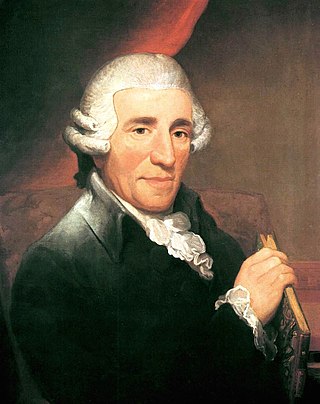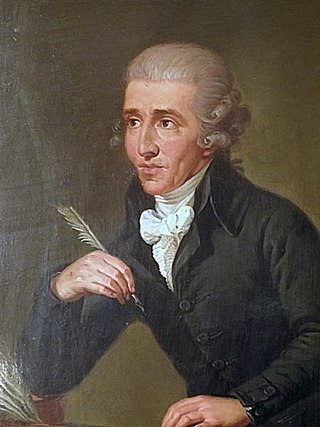
Symphony No. 44 in E minor, Hoboken I/44, was completed in 1772 by Joseph Haydn. It is popularly known as Trauer. An apocryphal story relates that Haydn asked for the slow movement of this symphony to be played at his funeral.

The Symphony No. 94 in G major is the second of the twelve London symphonies written by Joseph Haydn. It is popularly known as the Surprise Symphony.
Sonata rondo form is a musical form often used during the Classical and Romantic music eras. As the name implies, it is a blend of sonata and rondo forms.
Symphony No. 103 in E♭ major is the eleventh of the twelve London symphonies written by Joseph Haydn. This symphony is nicknamed The Drumroll after the long roll on the timpani with which it begins. It is from 1795, and his second-to-last symphony.
Joseph Haydn completed his Symphony No. 92 in G major, Hoboken I/92, popularly known as the Oxford Symphony, in 1789 as one of a set of three symphonies commissioned by the French Count d'Ogny. Instrumentation for the symphony is: flute, 2 oboes, 2 bassoons, 2 horns, 2 trumpets, timpani, and strings.

The Cello Concerto No. 1 in C major, Hob. VIIb/1, by Joseph Haydn was composed around 1761-65 for longtime friend Joseph Franz Weigl, then the principal cellist of Prince Nicolaus's Esterházy Orchestra.

The Symphony No. 100 in G major, Hoboken I/100, is the eighth of the twelve London symphonies written by Joseph Haydn and completed in 1793 or 1794. It is popularly known as the Military Symphony.
The Symphony No. 95 in C minor is the third of the twelve London symphonies written by Joseph Haydn. It is the only one of the twelve London symphonies in a minor key, and is also the only one of them to lack a slow introduction.
Symphony No. 88 in G major was written by Joseph Haydn, for the orchestra of Esterháza under the benevolent Prince Nikolaus Esterhazy. It is notably the first of his symphonies written after the completion of the six Paris symphonies in 1786.
Ludwig van Beethoven's Piano Sonata No. 2 in A major, Op. 2, No. 2, was written in 1795 and dedicated to Joseph Haydn. It was published simultaneously with his first and third sonatas in 1796. Donald Francis Tovey wrote, "The second sonata is flawless in execution and entirely beyond the range of Haydn and Mozart in harmonic and dramatic thought, except in the Finale."
The six String Quartets, Op. 76, by Joseph Haydn were composed in 1797 or 1798 and dedicated to the Hungarian count Joseph Georg von Erdődy (1754–1824). They form the last complete set of string quartets that Haydn composed. At the time of the commission, Haydn was employed at the court of Prince Nicolaus Esterházy II and was composing the oratorio The Creation as well as Princess Maria Hermenegild Esterházy's annual mass.

Joseph Haydn's Symphony No. 31 in D major, Hob. I/31, was composed in 1765 for Haydn's patron Nikolaus Esterházy. It is nicknamed the "Hornsignal Symphony", because it gives a prominent role to an unusually large horn section of four players. Probably because of its prominent obbligato writing for the horns, in Paris, the publisher Sieber published this symphony as a "symphonie concertante" around 1785.
The Piano Sonata in E-flat major, Hob. XVI/52, L. 62, was written in 1794 by Joseph Haydn. It is the last of Haydn's piano sonatas, and is widely considered his greatest. It has been the subject of extensive analysis by distinguished musicological personages such as Heinrich Schenker and Sir Donald Tovey, largely because of its expansive length, unusual harmonies and interesting development. The sonata is sometimes referred to as number 62 based on the numbering of Landon instead of the numbering of Hoboken.
The Op. 33 String Quartets were written by Joseph Haydn in the summer and Autumn of 1781 for the Viennese publisher Artaria. This set of string quartets has several nicknames, the most common of which is the "Russian" quartets, because Haydn dedicated the quartets to the Grand Duke Paul of Russia and many of the quartets were premiered on Christmas Day, 1781, at the Viennese apartment of the Duke's wife, the Grand Duchess Maria Feodorovna. The "Russian" quartets were some of Wolfgang Amadeus Mozart's favorite works by Haydn and in 1785 Mozart dedicated six string quartets to Haydn in admiration of the quartets.

The Violin Concerto No. 4 in G major by Joseph Haydn is one of the composer's three surviving violin concertos.

The String Quartets, Op. 50, were composed by Joseph Haydn in 1787. The set of six quartets was dedicated to King Frederick William II of Prussia. For this reason the set is commonly known as the Prussian Quartets. Haydn sold the set to the Viennese firm Artaria and, without Artaria's knowledge, to the English publisher William Forster. Forster published it as Haydn's Opus 44. Haydn's autograph manuscripts for Nos. 3 to 6 of the set were discovered in Melbourne, Australia, in 1982.





